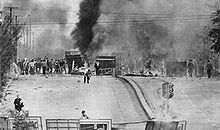Argentine Revolution
This article needs additional citations for verification. (November 2013) |
| 1966 Argentine coup d'état | |||||||
|---|---|---|---|---|---|---|---|
| Part of the Cold War | |||||||
 Generals Juan Carlos Onganía, Roberto Marcelo Levingston and Alejandro Agustín Lanusse, the three successive dictators of the "Revolución Argentina". | |||||||
| |||||||
| Belligerents | |||||||
|
|
| ||||||
| Commanders and leaders | |||||||
| Arturo Umberto Illia | |||||||
| History of Argentina |
|---|
 |
|
|
| Part of a series on |
| Political revolution |
|---|
 |
|
|
Argentine Revolution (Spanish: Revolución Argentina) was the name given by its leaders to a military coup d'état which overthrew the government of Argentina in June 1966 and began a period of military dictatorship by a junta from then until 1973.
The Revolución Argentina and the "authoritarian-bureaucratic state"
The June 1966 coup established General Juan Carlos Onganía as de facto president, supported by several leaders of the General Confederation of Labour (CGT), including the general secretary Augusto Vandor.
This was followed by a series of
While preceding military coups were aimed at establishing temporary, transitional
Onganía's rule (1966–70)
Onganía implemented
The workers' movement divided itself between Vandoristas, who supported a "Peronism without Perón" line (Augusto Vandor, leader of the General Confederation of Labour, declared that "to save Perón, one has to be against Perón") and advocated negotiation with the junta, alongside "Participationists" headed by José Alonso, and Peronists, who formed the General Confederation of Labour of the Argentines (CGTA) in 1968 and were opposed to any kind of participation with the military junta. Perón himself, from his exile in Francoist Spain, maintained a cautious and ambiguous line of opposition to the regime, rejecting both the endorsement and open confrontation.
Cultural and education policies

Onganía ended university autonomy, which had been achieved by the University of 1918.[2]
He was responsible for the July 1966 La Noche de los bastones Largos ("The Night of the Long Truncheons"), where university autonomy was violated, in which he ordered police to invade the Faculty of Sciences of the University of Buenos Aires. They beat up and arrested students and professors. The university repression led to the exile of 301 university professors, among whom were Manuel Sadosky, Tulio Halperín Donghi, Sergio Bagú, and Risieri Frondizi.[3]
Onganía also ordered repression on all forms of "immoralism", proscribing
Change of direction of the Armed Forces
Towards the end of May 1968, General
Increasing protests
On 19 September 1968, two important events affected Revolutionary Peronism.

In 1969, the CGT de los Argentinos (led by
In December 1969, more than 20 priests, members of the
The same year, the MSTM issued a declaration supporting Socialist revolutionary movements, which led the
Various armed actions, headed by the Fuerzas Armadas de Liberación (FAL), composed by former members of the
Levingston's rule (1970–71)
Faced with increasing opposition, in particular following the
A coalition of political parties issued the statement known as La Hora del Pueblo ("Time of the People"), calling for free and democratic elections which would include the Justicialist Party. Under this pressure, Levingston was ousted by an internal coup headed by the Chief of Staff of the Armed Forces and strongman of the Revolución Argentina, General Alejandro Agustín Lanusse.
Lanusse's rule (1971–73)
The last of the military presidents de facto of this period,
General Lanusse tried to respond to the Hora del Pueblo declaration by calling elections but excluding Peronists from them, in the so-called Gran Acuerdo Nacional (Great National Agreement). He nominated Arturo Mor Roig (Radical Civic Union) as Minister of Interior, who enjoyed the support of the Hora del pueblo coalition of parties, to supervise the coming elections.
There had been no elections since 1966, and armed struggle groups came into existence, such as the Ejército Revolucionario del Pueblo (ERP, the armed wing of the Workers' Revolutionary Party, PRT), the Catholic nationalist Peronists Montoneros and the Fuerzas Armadas Revolucionarias (FAR).
In August 1972, an attempt by several revolutionary members to escape from prison, headed by Mario Roberto Santucho (PRT), was followed by what became known as the Trelew massacre. Fernando Vaca Narvaja, Roberto Quieto, Enrique Gorriarán Merlo and Domingo Menna managed to complete their escape, but 19 others were re-captured. 16 of them, members of the Montoneros, the FAR, and the ERP, were killed, and 3 managed to survive. On the same night of August 22, 1972, the junta approved law 19,797, which proscribed any information concerning guerrilla organizations. The massacre led to demonstrations in various cities.
Finally, Lanusse lifted the proscription of the Justicialist Party, although he maintained it concerning Juan Perón by increasing the number of years of residency required of presidential candidates, thus excluding de facto Perón from the elections since he had been in exile since the 1955 Revolución Libertadora.
Henceforth, Perón decided to appoint as his candidate his personal secretary Héctor José Cámpora, a leftist Peronist, as representative of the FreJuLi (Frente Justicialista de Liberación, Justicialist Liberation Front), composed of the Justicialist Party and minor, allied parties. The FreJuLi's electoral slogan was "Cámpora in Government, Perón in power" (Cámpora al Gobierno, Perón al poder).
See also
Notes
- ^ Guillermo O'Donnell, El Estado Burocrático Autoritario, (1982)
- ^ EHESS), Put on line on 15 June 2008. URL: http://nuevomundo.revues.org//index35983.htmlAccessed on 28 July 2008. (in French)
- ^ Marta Slemenson et al., Emigración de científicos argentinos. Organización de un éxodo a América Latina (?, Buenos Aires, 1970:118)
- ^ a b Oscar R. Anzorena, Tiempo de violencia y utopía (1966-1976), Editorial Contrapunto, 1987, p.48 (in Spanish)
- ^ Oscar Anzorena, 1987, p.49
- ^ Oscar Anzorena, 1987, p.53
References
- Oscar R. Anzorena, Tiempo de violencia y utopía (1966-1976), Editorial Contrapunto, 1987

